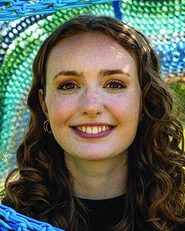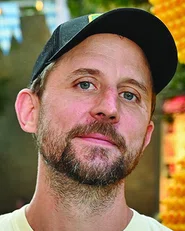


Blumenthal Arts
IGNITING CULTURE
Winter 2024


Featured CIAF Artists
Celebrating the Blumenthal Arts Fellows Class of 2023

Angela Clousher

Rosa Diaz

Anuja Jain

Claire Kiester

Dorne Pentes

Laurie Smithwick

Tara Spil

Mike Wirth

Greg Urquhart
by Liz Rothaus Bertrand
The second annual Charlotte International Arts Festival in September brightened the cityscape from uptown Charlotte to Ballantyne with hundreds of interactive installations and performances. Among the works curated from around the world, and celebrating Charlotte’s own international community, were nine featured creations from the Blumenthal Fellows Class of 2023.
These local visual artists created a wide range of colorful, interactive and wildly inventive experiences that promised to spark joy, pique curiosities, and offer moments of quiet contemplation.
Here’s a behind-the-scenes look at all nine projects and the artists who created them, listed alphabetically by artist’s last name.
Here’s a behind-the-scenes look at all nine projects and the artists who created them, listed alphabetically by artist’s last name.
Angela Clousher
Project name: “Inorganica: Flora and Fauna of the Sea”
Angela Clousher's “Inorganica: Flora and Fauna of the Sea.”
For as long as she can remember, visual artist Angela Clousher has tried to find creative ways to reuse objects.
“I love to take things that would be thrown out and kind of give them a new life and rework them and just make them completely unrecognizable.”
She used that same approach to create her first, large-scale public artwork as a Blumenthal Fellow: a beautiful undersea world made from materials like plastic bottles, Styrofoam, old screens, spray paint caps and bubble wrap.
“Inorganica” takes part of its inspiration from the floating islands of trash that litter the ocean. Her project was sponsored by Wastequip, the leading waste handling equipment manufacturer in North America.
About the artist: Angela Clousher is a Charlotte-based artist who works in a variety of materials including woodwork, painting, resin and furniture building. Learn more about Clousher and her artwork on Instagram @artbyangelaclousher.
Rosa Diaz
Project name: "Dreamcatcher Labyrinth"
Rosa Diaz's "Dreamcatcher Labyrinth."
For Rosa Diaz – an artist best known for her surrealist style paintings, ceramic work and digital creations – her “Dreamcatcher Labyrinth," project was new territory. It was her first interactive art installation and her biggest artwork yet.
It was a large labyrinth modeled after the Native American tradition of handmade, webbed dreamcatchers, but stretching 40 feet in diameter. Originally created by the Ojibwa people, dreamcatchers traditionally have been hung above beds to protect sleeping children.
Diaz, who grew up in El Salvador, became fascinated with Native American culture through anthropology classes. The bed was decorated with ropes fashioned into a weblike structure, as well as big iron beads to represent the “dreams” Native American people have long sought, including social justice, peace and protection of the environment.
It was a large labyrinth modeled after the Native American tradition of handmade, webbed dreamcatchers, but stretching 40 feet in diameter. Originally created by the Ojibwa people, dreamcatchers traditionally have been hung above beds to protect sleeping children.
Diaz, who grew up in El Salvador, became fascinated with Native American culture through anthropology classes. The bed was decorated with ropes fashioned into a weblike structure, as well as big iron beads to represent the “dreams” Native American people have long sought, including social justice, peace and protection of the environment.
About the artist: Rosa Diaz is a self-taught artist and entrepreneur originally from El Salvador. Learn more about Diaz and her artwork at nativastudio.com or on Facebook and Instagram at @rosadiazart.
Anuja Jain
Project name: "Birdhouse Forest"
Anuja Jain's "Birdhouse Forest."
Anuja Jain is a mandala artist who found that the practice of creating the intricate patterns helped calm her down and meditate.
Mandalas are a centuries-old artform, she said. Different types of patterns and traditions revolve around their use in Buddhist and Hindu religious practices. Jain said her artwork combines visual elements of both traditions and is also influenced by henna art.
Her Blumenthal Fellow’s creation comprised 30 birdhouses of varying shapes and structures.
The project, which was designed as a nature walk on the same trail that featured 100 Tiny Things, also included bird sounds and little surprises like colorful artificial butterflies and birds for visitors to find.
Mandalas are a centuries-old artform, she said. Different types of patterns and traditions revolve around their use in Buddhist and Hindu religious practices. Jain said her artwork combines visual elements of both traditions and is also influenced by henna art.
Her Blumenthal Fellow’s creation comprised 30 birdhouses of varying shapes and structures.
The project, which was designed as a nature walk on the same trail that featured 100 Tiny Things, also included bird sounds and little surprises like colorful artificial butterflies and birds for visitors to find.
About the artist: Anuja Jain is a self-taught artist, originally from India. She specializes in mandala art. Learn more about Jain and her artwork on Instagram @mandalasbyanuja.
Claire Kiester
Project name: “Luminous Loops”
Claire Kiesters “Luminous Loops.”
When people think of fiber arts, they often envision wearable fashion like sweaters and socks, but artist Claire Kiester created "Luminous Loops" as a large-scale crocheted installation in gorgeous shades of blue.
Constructed with PVC pipes, rope, paracord and yarn made from recycled plastic bags, it was large enough for groups of people to walk inside. It also had lights that illuminated it at night.
Kiester has always loved textures and textiles, and she also has a special interest in using recycled materials and reducing waste in her work. Her project also incorporated recycled ropes and reused outdoor tarps to create the roof.
Constructed with PVC pipes, rope, paracord and yarn made from recycled plastic bags, it was large enough for groups of people to walk inside. It also had lights that illuminated it at night.
Kiester has always loved textures and textiles, and she also has a special interest in using recycled materials and reducing waste in her work. Her project also incorporated recycled ropes and reused outdoor tarps to create the roof.
About the artist: Claire Kiester is a 2021 graduate of the School of the Art Institute of Chicago, where she focused on printmaking and fiber arts. Learn more about Keister and her artwork at clairekiester.com or on Instagram @clairekiester_art.
Dorne Pentes
Project name: “Critterz”
Dorne Pentes' "Crittez."
Artist Dorne Pentes aims to bring happiness and joy through his creations. His inflatable, whimsical “Critterz” started as doodles during the pandemic. He first turned them into characters in several children’s books he created.
One night, he dreamt of the “Critterz” floating through the air, telling him they wanted to be big and blown up.
“Critterz” included standing figures as well as giant hearts and eyeballs that were suspended in the air. Made from ripstop nylon fabric, they ranged in size from about 4 to 16 feet tall. Sound and colorful LED lights also helped bring the “Critterz” to life.
One night, he dreamt of the “Critterz” floating through the air, telling him they wanted to be big and blown up.
“Critterz” included standing figures as well as giant hearts and eyeballs that were suspended in the air. Made from ripstop nylon fabric, they ranged in size from about 4 to 16 feet tall. Sound and colorful LED lights also helped bring the “Critterz” to life.
About the artist: Alongside his illustration and inflatable art, Dorne Pentes is a filmmaker. Learn more about Pentes and his artwork at pentesstudios.com or at Instagram @pentesstudios.
Laurie Smithwick
Project name: "Pilgrimage"
Laurie Smithwick's "Pilgrimage."
For the last few years, Laurie Smithwick has been obsessed with the idea of portals. She thinks about them, she’s made art inspired by them, and she’s reviewed her own life in terms of befores and afters.
At CIAF, Smithwick took that concept to a grand scale with “Pilgrimage.” From far away, the plastic, multicolored shapes appeared to create a sculpture. Up close, they were separate translucent arches spread out and ranging from 3 feet to 8 feet high – perfect for visitors of all ages to play around and walk or crawl through.
She worked with Murray Chapple from WhirlyPig Design to engineer and fabricate everything.
As people made their way back and forth across the 40-foot-or-so pilgrimage, Smithwick hoped they would be conscious of the before and after of their journey. Visitors’ movements also activated sound.
About the artist: Charlotte native Laurie Smithwick is an abstract painter, printmaker and muralist. Learn more about Smithwick and her artwork at lauriesmithwick.com or on Instagram @lauriesmithwick.
Tara Spil
Project name: “Framing Our Roots”
Tara Spil's “Framing Our Roots."
Artist Tara Spil uses her artwork to visually explore important issues and data points that affect communities. For her project at CIAF, she consulted with International House of Charlotte to identify information and numbers that are relevant to the local community.
"Framing Our Roots" consisted of three interactive frames for visitors to use for photo opportunities. As visitors stepped within the frames, they were surrounded by numbers, colors and information about the international community.
The featured data included facts about how many people in our community have foreign roots and how that plays out across the community.
"Framing Our Roots" consisted of three interactive frames for visitors to use for photo opportunities. As visitors stepped within the frames, they were surrounded by numbers, colors and information about the international community.
The featured data included facts about how many people in our community have foreign roots and how that plays out across the community.
About the artist: Tara Spil holds a bachelor’s in fine arts from Western Carolina University. Learn more about Spil at taraspil.com or on Instagram @tspilart.
Mike Wirth
Project name: "Rimon: The Cosmogranate"
Mike Wirth's "Rimon: The Cosmogranate."
"Rimon," which means pomegranate in Hebrew, started as an illustration in Mike Wirth's ongoing Jewish Futurism project where he imagines the adventures of The Wanderer, a futuristic Jewish traveler who explores what it means to be Jewish off the earth and in the cosmos.
In the series, Wirth takes a sacred symbol of Judaism, the pomegranate, and imbues it with special powers for The Wanderer.
“What's interesting from Judaism that's futuristic is reinvention,” Wirth said. “… That kind of adaptation of Judaism to its time, its place and, you know, its solar system in the future.”
Through his artwork Wirth said he tries to reimagine and reignite a passion for the core values that come from Jewish cultural tradition.
At CIAF, Wirth took his 2D concept into a 3D realm by creating an enormous, interactive pomegranate glowing with 14,000 LED lights and with an original soundscape.
In the series, Wirth takes a sacred symbol of Judaism, the pomegranate, and imbues it with special powers for The Wanderer.
“What's interesting from Judaism that's futuristic is reinvention,” Wirth said. “… That kind of adaptation of Judaism to its time, its place and, you know, its solar system in the future.”
Through his artwork Wirth said he tries to reimagine and reignite a passion for the core values that come from Jewish cultural tradition.
At CIAF, Wirth took his 2D concept into a 3D realm by creating an enormous, interactive pomegranate glowing with 14,000 LED lights and with an original soundscape.
About the artist: Mike Wirth is an artist and associate professor of graphic design at Queens University of Charlotte. Learn more about Wirth and his artwork at mikewirthart.com or on Instagram @mikewirth.
Greg Urquhart
Project name: “What the Duck”
Mike Wirth's "Rimon: The Cosmogranate."
Artist Greg Urquhart wanted to bring CIAF visitors back to their childhood days with his installation “What the Duck.” The artwork was a 6-foot-tall, double-sided giant duck made of thousands of 1.5 inch rubber ducks – 3,484 to be exact.
The sculpture, which was mounted on a large wooden platform, also incorporated LED lights that gave the sculpture a halo effect.
He said he’s drawn to the rubber duck primarily because of its nostalgia factor and the joyful emotions it stirs in people.
The sculpture, which was mounted on a large wooden platform, also incorporated LED lights that gave the sculpture a halo effect.
He said he’s drawn to the rubber duck primarily because of its nostalgia factor and the joyful emotions it stirs in people.
About the artist: Greg Urquhart works with a variety of mediums, including wood, resin and acrylics. Learn more about Greg Urquhart and his artwork on Instagram @projectgworkshop. ◼





